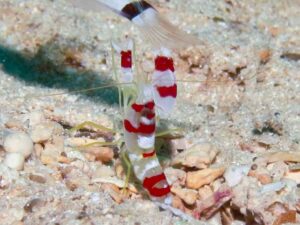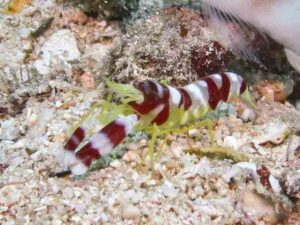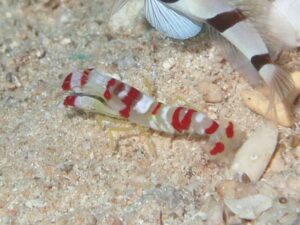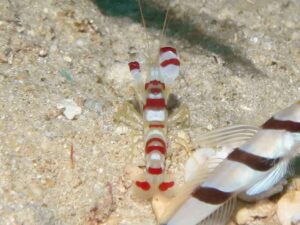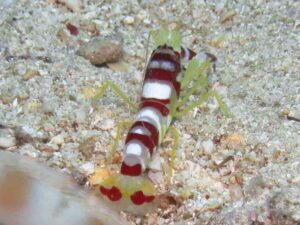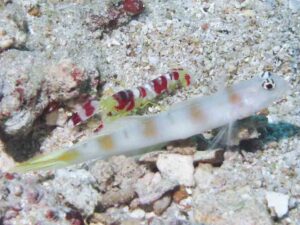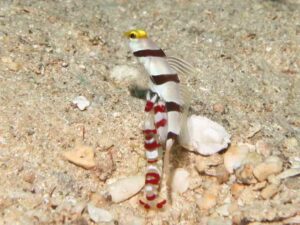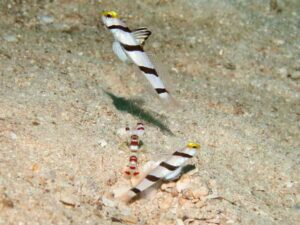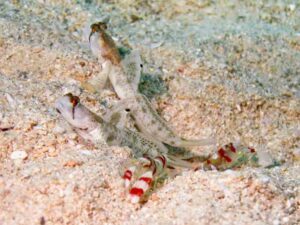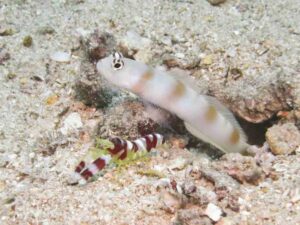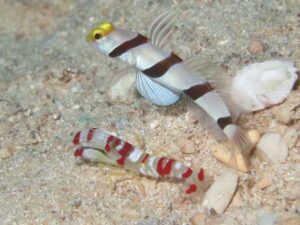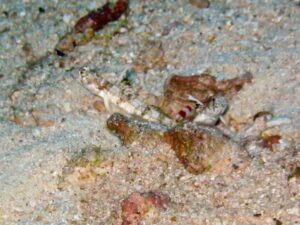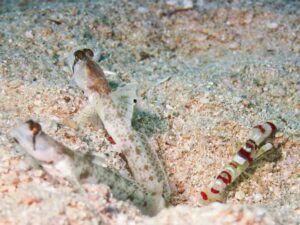Randall’s Snapping Shrimp
Alpheus randalli
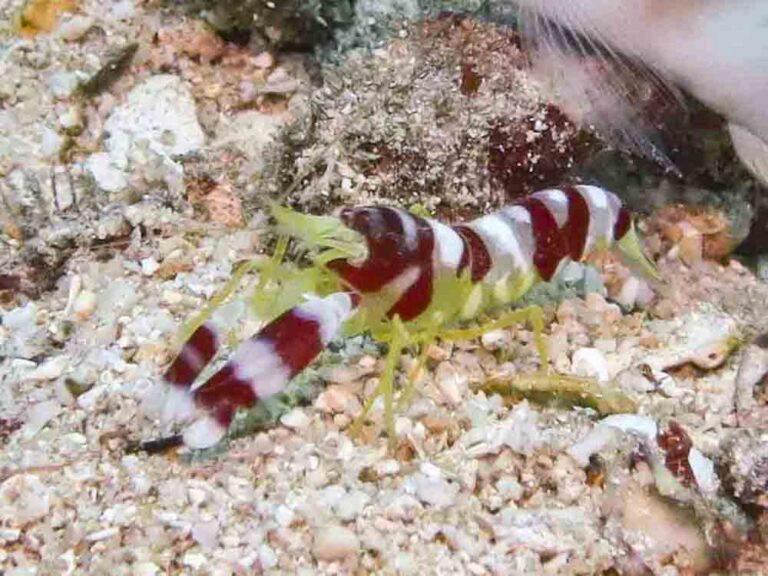
Randall’s Snapping Shrimp
Alpheus randalli
Banner & Banner, 1980
Description
A beautiful, distinctive shrimp with a semi-transparent body decorated with bold red and white patches contrasting with the bright yellow-green legs and rostrum. Alpheus randalli is a medium-sized snapping shrimp growing to about 3 centimetres long.
Carapace: The carapace is not laterally compressed. The dorsum is marked with alternating red and white patches. The posterior white patch may take the form of a well-defined saddle. The red patches extend onto the side of the carapace.
The abdomen is translucent with a red band at the junction with the carapace. This is followed by a white band, then a red outlined square, then another white band, and a red band at the base of the tail.
The tail itself is translucent grey with red markings and sometimes a yellow-green patch anterior to these.
The legs are bright yellow-green.
The rostrum is half as long again as it is broad. It is yellow-green and the antennae are pale brown.
The pincers or chelipeds are asymmetric, one carrying a massive snapping claw. They are white or transparent with red bands and spots on both the large and small chelipeds.
On black sand, the transparent areas are reduced in extent and the colour pattern shows more red and less white
The alternating red and white bands on a transparent background vary in thickness with habitat but are distinctive enough to define the species.
Similar Shrimps
None. This a very distinctive species and should not be confused with any other.
Nomenclature
The scientific name Alpheus randalli, Banner and Banner, 1980 has been applied to this species.
This is the only species of the edwardsii group which is permanently associated with shrimpgobies, Debelius (2001).
Debelius (2001) Crustacea p151 has images of a similar-looking shrimp and gives the name Alpheus randalli, with the common name Randall’s Snapping Shrimp. Length up to 3 cm. The distribution of the West Pacific is from Japan and Indonesia to the Marquesas Islands.
Ryanskiy (2016) p7. has images of a similar-looking shrimp and gives the name Alpheus randalli the common name Randall’s Snapping Shrimp. Length up to 3 cm. Distribution Indo-West Pacific – Maldives, Seychelles, Japan, Philippines, Indonesia.
Humann & DeLoach (2010) p84 has images of a similar-looking shrimp and gives the name Alpheus randalli, with the common name Randall’s Snapping Shrimp. Size to 2. 5 cm. Pacific also Japan. Two variations, red with white banding and white with red banding.
Hayashi & Shiratori (2003) Alpheus randalli from Japan.
Roger Steene (2015) p. 407 has a vividly marked individual on black sand labelled Alpheus randalli.
Alternative common names:
Red-banded Goby-shrimp Kuiter and Debelius (2009), Randall’s Snapping Shrimp, Debelius (2001) and Ryanskiy (2016). Also the Redbanded Snapping Shrimp, Randall’s Pistol Shrimp, Candy Stripe Pistol Shrimp, Candy Cane Shrimp. (WoRMS)
We have not seen this shrimp form a pair with any of the other shrimps described in this book. Within this species, there are variations in the relative proportions of red and white. We do not know whether this is genetically or habitat-determined.
Ecology
HABITAT
Preferred substrate Coarse bare sand with coral rubble between bommies or in channels.
Depth range from 5 to 30 metres.
Proximity to reef Burrows may be constructed either amongst the coral in small sand patches or away from the reef in areas of reasonable currents in channels and bays with good currents, clean water and coarse sand with coral rubble.
NATURAL HISTORY
These industrious shrimps usually work in pairs. Being a conspicuously pretty shrimp there are useful records in photographic books. There seems to be a predilection for partnership with Stonogobiops shrimpgobies. Our experience of this has been with Stonogobiops xanthorhinica, the yellow-nose goby.
The interaction between these two is vigorous because of problems with maintaining antennae contact. This is a fish that habitually hovers twenty centimeters or so above the burrow feeding in the water column rather than on the sand. This puts it out of reach of the shrimp’s antennae. They react by stretching up and hauling the goby down by its tail. Then, for good measure, they give it a good nip to keep it in its place!
Behaviour
They have an unusual method of moving sand. They will come to the burrow entrance and then turn around, facing the entrance and shoot the sand out behind it using its pleopods (the small fins under the abdomen). We have not observed this behaviour in any other shrimps but it is very effective. Their nippers appear to be more rounded and less capable of bulldozing than other shrimp species.
A specific relationship
There is an interesting specificity in the association made between this shrimp and certain shrimpgobies. On one large reef terrace in the Solomon Islands, there is a widespread colony of Amblyeleotris guttata living with a range of four shrimps. None are associated with Randall’s Snapping Shrimp, nor have we ever recorded such an association. In the middle of this, in a small area of perhaps six square metres of identical-looking habitat, there are half a dozen colonies of Amblyeleotris yanoi, the Flagtail Shrimpgoby living in burrows exclusively with Randall’s Snapping Shrimps, the only ones to be found on this ledge which is about 60 x 30 metres in extent.
Feeds on detritus, algae and small invertebrates, Ryanskiy (2016).
Distribution
Published distribution:
West Pacific, from Japan and Indonesia to the Marquesas Islands Debelius (2001). Indo-West Pacific; Seychelles, Maldives, Japan, Philippines, Indonesia, Ryanskiy (2016). Bali, Indonesia. Widespread Indo-Pacific, Kuiter and Debelius (2009). Pacific, also Japan, Humann and DeLoach (2010).
Our records:
Solomon Islands; Kolombangara Island, Ghizo, Santa Isabel Island and Soghonangola Island.
Associated Goby species
Associated Shrimpgobies (four species)
Amblyeleotris yanoi, Flagtail Shrimpgoby
Stonogobiops xanthorhinica, Yellow-nose Shrimpgoby
Tomiyamichthys alleni, Allen’s Shrimpgoby
Tomiyamichthys oni, Monster Shrimpgoby
Other Records
Amblyeleotris steinitzi, Debelius (2001).
Flabelligobius in Allen et al. (2003) p. 301
Stonogobiops dracula in Kuiter and Debelius (2007) p. 329
Stonogobiops nematodes in Allen et al. (2003) p. 310
Stonogobiops yasha in Allen et al. (2003) p. 310
Stonogobiops medon in Allen et al. (2003) p. 310
Tomiyamichthys species, Yellowfin Shrimpgoby in Allen et al. (2003) p. 311

